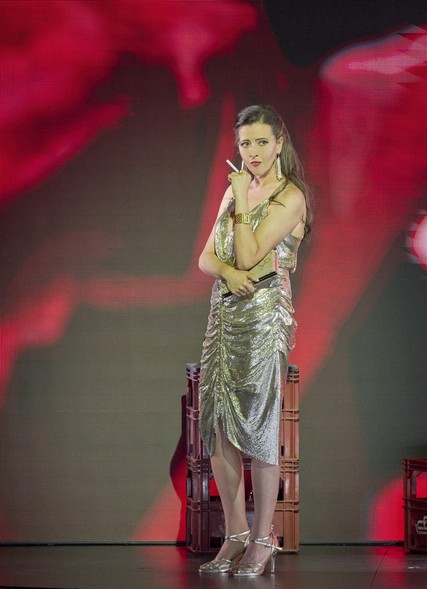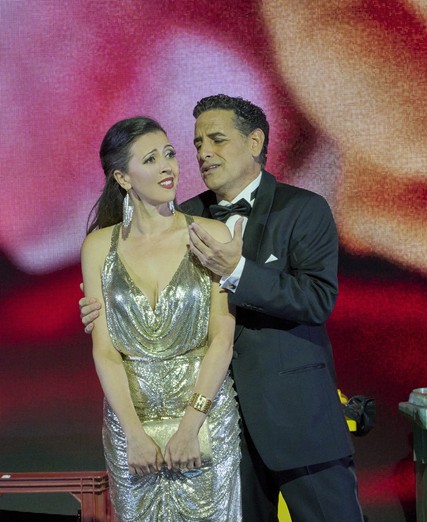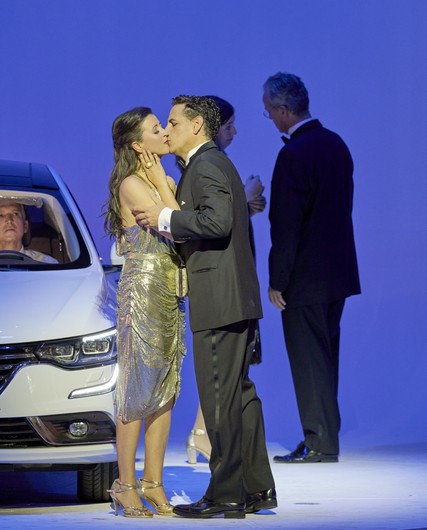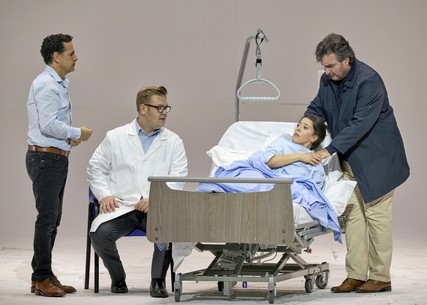La traviata
Music by
Giuseppe Verdi
Cast
| Violetta Valery | Lisette Oropesa | |
| Alfredo Germont | Juan Diego Florez | |
| Giorgio Germont | Ludovic Tézier | |
| Flora Bervoix | Alma Neuhaus | |
| Annina | Noa Beinart | |
| Gastone | Carlos Osuna | |
| Baron Douphol | Michael Arivony | |
| Marqués D' Obigny | Jack Lee | |
| Doctor Grenvil | Ilja Kazakov |
Conductor
Pier Giorgio Morandi
DirectorSimon Stone
Set DesignerRobert Cousins
CostumesAlice Babidge
LightingJames Farncombe
VideographerZakk Hein
About
La traviata tells the story of Violetta Valéry, a venal object of desire in Parisian society, who finds love in Alfredo but gives in to his father's social conceit and separates from him. In his spectacularly juggling production with huge video walls and social media, Simon Stone transposes this story to the present day. Violetta, that is a Parisian It-girl, an influencer who remains trapped in the Instagram bubble and whose life is at the mercy of the virtual presentation and show greed. Lonely in the public sphere, she is an outsider.
Reviews
WIEN / Staatsoper: LA TRAVIATA mit Oropesa, Floréz & Dupuis
Allen voran die mitreißend singende wie auch darstellerisch berührende Lisette Oropesa in der Titelrolle. Die kubanisch-amerikanische Sopranistin bringt alles mit, was für diese Rolle essenziell ist: Eine wunderschöne Stimme, gerade groß genug, hell und fein timbriert, ausdrucksstark und technisch so versiert, dass sie mit eleganter Leichtigkeit anmutig und geradezu schwerelos durch die Kadenzen schweben kann. Sie ist zu zartestem Pianissimo fähig, aber auch in kraftvolle Sequenzen wie in „Sempre lbera“ sattelfest. Bewundernswert, wie sich Oropesa in den sich ändernden Gefühlswelten verwandeln kann, von verliebter Glückseligkeit im ersten Akt bis zur erschütternden Verzweiflung in „Addio del passato“ und dem letzten Aufflackern des Lebens- und Liebenswillen angesichts des Todes. Darstellerisch überzeugt sie mit ehrlicher, liebenswerter Aufrichtigkeit, nicht mit großen Gesten.Foremost among them is the captivatingly singing and emotionally engaging Lisette Oropesa in the title role. The Cuban-American soprano possesses everything essential for this role: a beautiful voice, just large enough, bright and finely timbred, expressive and technically skilled enough to gracefully and almost weightlessly float through the cadenzas with elegant ease. She is capable of the most delicate pianissimo, but also solid in powerful sequences like in "Sempre libera." Admirable is how Oropesa can transform herself in the changing emotional worlds, from the blissful joy of being in love in the first act to the heartbreaking despair in "Addio del passato" and the final flicker of life and will to love in the face of death. In her portrayal, she convinces with honest, lovable sincerity, not with grand gestures.— Manfred A. Schmid • Online Merker
"La Traviata": Betörender Seelengesang in der Wiener Staatsoper
US-Sängerin Lisette Oropesa begeistert in Simon Stones Inszenierung an der Staatsoper. Diese aber geraten in den Hintergrund, wenn eine Sängerin wie Lisette Oropesa als Violetta Valéry auf der Bühne steht: Sie verkörpert glaubwürdig diese junge, heutige Frau, die schicke Partys feiert, per SMS kommuniziert und dabei betört sie mit ihrer famosen Stimme. Denn sie verfügt über einen lyrischen Koloratursopran. Fulminante Ausbrüche sind bei ihr genauso möglich wie atemberaubende Lyrismen, feines, zartes Vibrato. Zuweilen erinnert die in New Orleans geborene Amerikanerin an Ileana Cotrubas. Wenn sie nach dem Fest im ersten Akt durch Stones Paris wandelt, und ihr „Sempre libera“ intoniert, ist das von einzigartiger Wahrhaftigkeit. Mit ihrer brillanten Technik changiert sie mit Eleganz zwischen Ausdruck und betörendem Seelengesang.US singer Lisette Oropesa dazzles in Simon Stone's production at the State Opera. Yet, these fade into the background when a singer like Lisette Oropesa stands on stage as Violetta Valéry: She credibly embodies this modern, young woman who throws chic parties, communicates via text messages, and captivates with her fabulous voice. For she possesses a lyrical coloratura soprano. Explosive outbursts are just as possible for her as breathtaking lyrical passages, delicate, gentle vibrato. At times, the New Orleans-born American reminds one of Ileana Cotrubas. When she wanders through Stone's Paris after the party in the first act, and intones her "Sempre libera," it is of a unique authenticity. With her brilliant technique, she elegantly fluctuates between expression and enchanting soulful singing.— Susanne Zobl • Kurier
„La Traviata“ an der Staatsoper: Diese Violetta überragt alle
Lisette Oropesa beweist sich an der Staatsoper als eine der Diven unserer Zeit. Juan Diego Floréz als Alfredo gefällt mit Gefühl. a tut es wohl, wenn man eine subtil agierende Darstellerin wie Lisette Oropesa hat, die dem besonders elegant entspricht. Sie macht die Fotos mehr nebenbei, locker aus dem Handgelenk. Das nimmt dem Plakativen des ersten Akts nicht die Wirkung, ist aber weniger aufdringlich als bei Vorgängerinnen. Warmes Timbre, brillante SpitzenGenerell ist Oropesa wohl eine der besten Violettas, die man derzeit hören und sehen kann. Wie sie unter der Forderung von Alfredos Vater, auf diesen zu verzichten, förmlich zerbricht, wie sie sich fragil gegen die fortschreitende Krankheit wehrt, wie die Liebe zu Alfredo sich nicht ersticken lässt – das war ganz starkes Singschauspiel. Vor allem aber ließ die gesangliche Gestaltung keine Wünsche offen: Warm timbriert, mit exakten Koloraturen und Phrasierungen sowie brillanten Spitzentönen bewies sie sich als eine der Diven unserer Zeit. Herausragend, mit welcher Qualität sie sowohl die Leuchtkraft für den ersten Akt als auch die Lyrismen für das Folgende aufbringt.Lisette Oropesa proves herself at the State Opera as one of the divas of our time. Juan Diego Flórez as Alfredo pleases with emotion. It truly benefits when you have a subtly acting performer like Lisette Oropesa, who embodies elegance with charm. She takes photos more casually, effortlessly from the wrist. This doesn't diminish the impact of the first act's overt nature but is less intrusive than her predecessors. Warm timbre, brilliant highs. Generally, Oropesa is probably one of the best Violettas you can hear and see right now. How she virtually breaks under the demand of Alfredo's father to give him up, how she fragilely fights against the progressing illness, how the love to Alfredo cannot be extinguished – that was a very strong singing performance. Above all, the vocal interpretation left nothing to be desired: Warmly timbred, with precise coloraturas and phrasings as well as brilliant high notes, she proved herself as one of the divas of our time. Remarkable is the quality with which she brings both the luminosity for the first act and the lyricism for the following.— Theresa Steininger • Die Presse
Die verruchten Opernmädchen sind hier die Stars!
Erst recht, wenn die „Traviata“ unserer Tage auf der Bühne steh: Lisette Oropesa ist mit ihrem herrlich leuchtenden Zaubersopran und ihrem intensiven Spiel einfach eine Wucht zwischen Koloraturfreuden und zu Tränen rührendem Sichen und Sterben.Especially when the "Traviata" of our times takes the stage: Lisette Oropesa, with her splendidly radiant coloratura soprano and her intense acting, is simply overwhelming, between the joys of coloratura and the tear-inducing sighing and dying.— Stefan Musil • Kronen Zeitung
WIEN / Staatsoper: „LA TRAVIATA“ – vierte und letzte Vorstellung dieser Aufführungsserie
Lisette Oropesa ist mit ihrem lyrischen Koloratursopran, der sowohl zarte Lyrismen als auch dramatische Ausbrüche mühelos bewältigt, eine ideale Interpretin der Violetta Valéry, die in der Inszenierung von Simon Stone ja keine Kurtisane im Paris des 19. Jahrhunderts ist, sondern eine Influencerin der Gegenwart. Oropesa überzeugt sogar mehr als ihre Vorgängerin in der Premiere dieser Produktion. Man nimmt ihr sowohl die ausgelassene Lebensfreude zu Beginn als auch die Resignation und Verzweiflung über die fortschreitende Krebserkrankung ab.Lisette Oropesa, with her lyrical coloratura soprano which effortlessly handles both delicate lyricism and dramatic outbursts, is an ideal interpreter of Violetta Valéry, who in Simon Stone's production, is not a courtesan in 19th century Paris, but a modern influencer. Oropesa even surpasses her predecessor in the premiere of this production. We believe her both in her exuberant joy of life at the beginning and in her resignation and despair over the progressing cancer disease.— Walter Nowotny • Online Merker
Lisette Oropesa jako współczesna Traviata
W roli Traviaty wystąpiła Lisette Oropesa. Śpiewaczka robi ogromne wrażenie w scenach kameralnych, takich jak rozmowa z ojcem Alfreda czy finałowa scena śmierci, gdzie słychać delikatną, melancholijną barwę głosu i bajeczne piana. W pierwszym akcie słynna „E strano!…Ah, fors’è lui…Sempre libera” była popisem technicznej biegłości i koloraturowej sprawności, szkoda jednak że przerwana została w środku przez owacje publiczności, co zakłóciło stopniowe budowanie przez artystkę napięcia.Lisette Oropesa took the role of Traviata. The singer makes an enormous impression in intimate scenes, such as the conversation with Alfred's father or the final death scene, where the delicate, melancholic timbre of her voice and the fabulous pianissimos can be heard. In the first act, the famous "E strano!...Ah, fors'è lui...Sempre libera" displayed her technical proficiency and coloratura agility. However, it was a pity that it was interrupted in the middle by audience applause, which disrupted the gradual build-up of tension by the artist.— Magdalena Grzybowska • Opera Lovers
Performance History
Lisette has given 51 performances as Violetta Valery.
2026
Metropolitan Opera2025
Bayerische Staatsoper
Staatsoper Unter den Linden2024
Wiener Staatsoper
Opéra National de Paris2023
Teatro dell'Opera di Roma
Arena di Verona2022
Arena di Verona
Bayerische Staatsoper2021
Royal Opera House
Teatro dell'Opera di Roma2020
Gran Theatre del Liceu
Teatro Real
Metropolitan Opera2019
Arena di Verona
Greek National Opera2015
Opera Philadelphia






